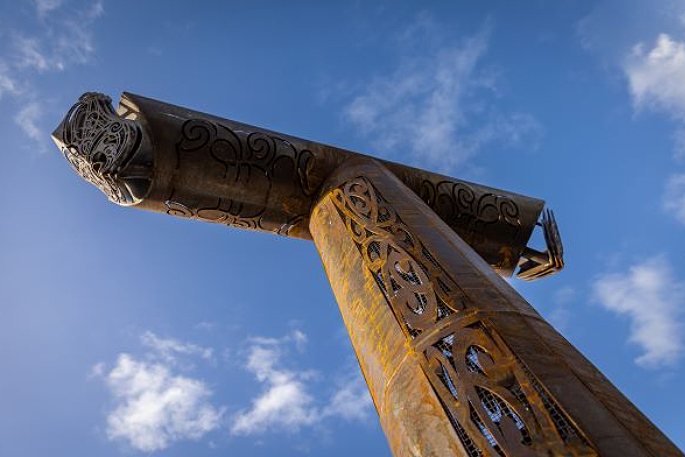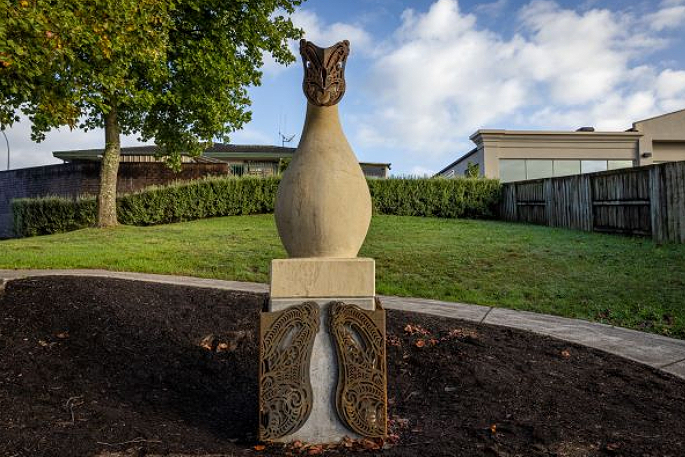Sculptures depicting some of the rich cultural history of the Te Papa Peninsula are now on display along Cameron Road, as an acknowledgement of our past to carry us into the future.
As well as road safety improvements, providing more transport options and upgrading 100-year-old water pipes under the road, the Cameron Road upgrade was also about making the area a more attractive destination for people, not just a commuting corridor.
The three 4.5m sculptures by Tauranga artist and carver Whare Thompson are placed at culturally significant locations along the corridor, and aim to share the rich history and stories of the area.
Whare (Ngāpuhi, Ngāti Whātua and Te Whakatōhea) hopes the design of the artworks will draw the community in for a closer look to reflect and connect with the kaupapa each piece represents.
The first piece near First Avenue represents a kō, a 2-3m traditional wooden digging stick, used for gardening. It is a reminder this area was once a place of fertile and productive gardens.
“Looking westward from here into the Waikareao Estuary you can see Motuopae Island, a former pā site and home to the ancestor Kinotaraia and his son Tuaurutapu.
“Kinotaraia was also known as Tamarāwaho which translates as ‘son of the sea breeze’ and is the ancestor from which the hapū takes its name.
“These days, the island is the urupa, burial ground, for Ngāi Tamarāwaho,” says Whare.
 The fountain design on top of 'Pataka' at Seventh Avenue is designed to catch rainwater which will gently spray out, symbolising the life cycle of growth. Photo credit: Matt Hunt.
The fountain design on top of 'Pataka' at Seventh Avenue is designed to catch rainwater which will gently spray out, symbolising the life cycle of growth. Photo credit: Matt Hunt.
Seventh Avenue is home to the next piece which represents a pātaka – a traditional storehouse for food or valuables. The design features an intricate kowhaiwhai pattern and is centrally lit to glow at night, symbolising the sun and moon.
“The kowhaiwhai pattern belongs to Ngāi Tamarāwaho and can also be seen woven into other pieces of cultural art in the area, including at Ōtūmoetai Primary School and Te Kura o Manunui.
“The fountain design on top of the structure is designed to catch rainwater which will gently spray out, symbolising the life cycle of growth,” says Whare.
 'Manaakitanga' at the SH2/Fifteenth Avenue intersection of Cameron Road tells a special story from the battle of Battle of Pukehinahina/Gate Pā, as well as representing the showing of care and respect for people. Photo credit: Matt Hunt.
'Manaakitanga' at the SH2/Fifteenth Avenue intersection of Cameron Road tells a special story from the battle of Battle of Pukehinahina/Gate Pā, as well as representing the showing of care and respect for people. Photo credit: Matt Hunt.
The artwork at the Fifteenth Avenue intersection with SH2 represents a water-carrying taha or bottle gourd made from the husk of a hue or gourd. It also represents the concept of manaakitanga - the showing of care and respect for people.
“In this case it is a reference to the Battle of Pukehinahina/Gate Pā in April 1864. Following the battle some Māori women are known to have tended to wounded soldiers by giving them water and loading them onto horses so they could be taken to the field hospital for treatment,” says Whare.
“One wāhine is believed to be either a teenager, Te Auetu, or her mother Matatu, both of Ngāi Tamarāwaho hapū.
“Their actions are also captured on a carved ceremonial pou on the actual battlefield at Gate Pā.”
The artworks are made from a combination of Corten steel and Hinuera stone and include an interpretative panel nearby. There are a further eight interpretive panels located along Cameron Road that share some of the Māori and European history of the area.
Ngāi Tamarāwaho spokesperson Buddy Mikaere says the works not only capture some key aspects of hapū history but are also a tribute to kaumātua Peri Kohu who strongly influenced many of the cultural aspects of the Cameron Road upgrade.
“Peri passed away in 2022. “I think Peri would have been very pleased with the outcome," says Buddy.
The artworks were unveiled at a dawn blessing of the completion of the project at the weekend.
Commissioner Bill Wasley says it’s great to celebrate the successful completion of this stage of the Cameron Road upgrade, which has created better, safer connections across the Te Papa Peninsula as well as making it more attractive and providing more ways to move around.



5 comments
Interesting
Posted on 16-04-2024 15:51 | By Yadick
Sculptures depicting some of the rich cultural history of the Te Papa Peninsula are now on display along Cameron Road, as an acknowledgement of our past to carry us into the future.
Yet a part of our history also involved the naming of some roads but because that particular history doesn't suit a call is made to look into renaming some roads. Who decides all this?
Sunlive, under the OIA can you provide us a cost breakdown for these sculptures as I see they are included as a part of the Cameron Road upgrade. As this is part of our rates I believe we have a right to know.
I think we need something more stable and positive to 'carry us into our future' as stated in the article.
Just ONE question ??
Posted on 16-04-2024 23:09 | By The Caveman
WHO is paying for this, and were they consulted about the cost ??
Sounds lovely
Posted on 17-04-2024 03:46 | By BryanBOP
This all sounds very nice but how much did this cost the ratepayers?
How much?
Posted on 17-04-2024 13:52 | By morepork
We want to know how much of our money was involved in this. Dishonestly making it a part of the Cameron Road refurbishment, so it can be hidden in that budget, is not going to win any friends. This is supposed to help us move into our future? Why are WE not consulted on things that are part of OUR future? I think the sculptures are excellent and I see no objection on cultural or artistic grounds, but why not be up-front and get community feedback BEFORE arbitrarily deciding what will be sculpted, what the budget will be, what funds it will come out of, and and where the sculptures will be placed? Don't just connive with Queen Anne; communicate with the community. Maybe these sculptures could have been done progressively instead of all at once, at a time when funds are tight.
Improvements
Posted on 19-04-2024 10:12 | By Kancho
Is Cameron road improved by 98 million dollars spent ? Well no I don't think so. Certainly a lot of extra lights and paint and plants etc. Seems the main purpose of a road being for vehicles is no better and probably worse especially for peak traffic. Greerton showed how to slow down traffic flow and these "improvements" seem to be a grand extension of this . Certainly impedes going to the businesses especially when bus lanes are active. Made me smile that of course busses will still get caught in traffic anyway as lanes disappear. So do these carvings add anything ? well for the odd pedestrian maybe as the wander about. Was the cost part of the massive over spend ? or worse the poor struggling to pay ratepayers on non core neglected council businesses. Town looking a bit better for the 856 council staff and
Leave a Comment
You must be logged in to make a comment.